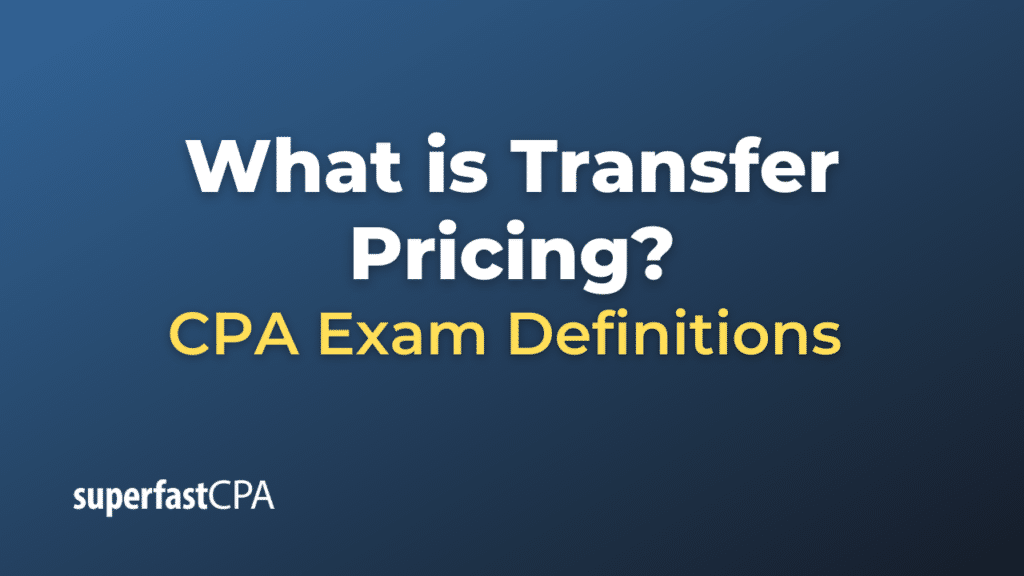Transfer Pricing
Transfer pricing refers to the rules and methods for pricing transactions within and between enterprises under common ownership or control. In essence, it’s the price at which divisions of a company transact with each other, such as during the trade of supplies or labor between departments. Transfer prices are used when individual subsidiaries of a large company sell and trade goods among themselves.
Here’s a more in-depth look at why transfer pricing is important:
- Profit Allocation: The price at which an exchange occurs affects the division of profit between the parts of the company and can influence where those profits are taxed.
- Tax Implications: Since tax rates vary between countries, there’s an incentive for multinational corporations to set transfer prices in a way that shifts income from high-tax jurisdictions to low-tax jurisdictions, thereby reducing the company’s overall tax liability.
- Regulatory Scrutiny: Due to the potential for profit shifting (moving profits from one country to another to capitalize on lower tax rates), many countries have established regulations to ensure that transfer pricing practices are set at “arm’s length.” The “arm’s length principle” requires that the amount charged by one related party to another for goods, services, or the use of property must be the same as it would have been had the parties not been related. This is to prevent businesses from manipulating prices to create an unfair tax advantage.
- Internal Considerations: For performance evaluation, budgeting, and resource allocation within a company, accurate transfer pricing practices are crucial. Misaligned transfer pricing can distort a subsidiary or department’s perceived performance.
International guidelines on transfer pricing, particularly those established by the Organisation for Economic Co-operation and Development (OECD), serve as a reference point for many countries in forming their regulations.
In essence, while transfer pricing is an internal process for companies, its implications are far-reaching, especially concerning taxes and compliance with national and international regulations.
Example of Transfer Pricing
Let’s use a hypothetical example to understand the concept of transfer pricing:
Company: GlobalCars Inc., a multinational corporation that produces automobiles.
Subsidiaries:
- GlobalCars US – Located in the United States, this subsidiary produces car engines.
- GlobalCars Mexico – Located in Mexico, this subsidiary assembles the cars using the engines and other parts.
Scenario:
- Internal Transaction:
GlobalCars US manufactures car engines at a cost of $5,000 each. They transfer these engines to GlobalCars Mexico for the final car assembly. For this transaction, GlobalCars US decides to charge GlobalCars Mexico $8,000 per engine. This establishes a transfer price and results in a recorded profit of $3,000 per engine for GlobalCars US. - Final Sale:
After assembling the car using the engine from GlobalCars US and other components, GlobalCars Mexico sells the finished car to dealerships around the world for $20,000 each.
Implications:
- Profit Allocation:
The transfer price determines how much profit is allocated to each subsidiary. GlobalCars US records a profit of $3,000 per engine due to the transfer price, while GlobalCars Mexico’s profit will be the difference between the car’s sale price and its production costs (which includes the transfer price of the engine). - Tax Implications:
Suppose the corporate tax rate in the US is higher than in Mexico. By setting a high transfer price, GlobalCars US has more profit, which might result in higher taxes. However, if they set a lower transfer price, more profit would be shifted to Mexico, potentially reducing the overall tax bill for the company if Mexico’s tax rate is lower. - Regulatory Scrutiny:
If tax authorities believe that the transfer price isn’t set at “arm’s length” (i.e., not what two independent entities would charge each other for a similar product), they might adjust the taxable income of the subsidiaries, leading to increased taxes and potential penalties.
In this example, the transfer price has direct implications for the profit each subsidiary reports and the taxes the company pays in each country. It illustrates why transfer pricing is not only an internal accounting mechanism but also a matter of significant external regulatory interest.













